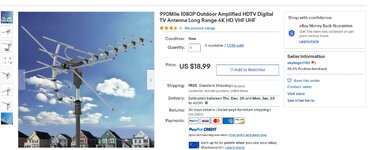scarlettpenelopegwe
Newbie

So I recently bought a Roku TV and loved it so much that we finally cut the cord. The apps are great and I was getting good but not great reception of local channels. Some occasional dropouts. Not brutal but distracting. I had a friend recommend an amplified antenna. I didn't want to ditch the antenna I had just bought, so I checked Best Buy (so I could pick it up today) and they sell an "inline cable amplifier". I put it on and saw significant improvement in the major networks. However, I also observed that it greatly denigrates PBS and FM radio. The box says "5-42/54-100 MHz compatible. Our PBS station broadcasts on digital 13.1, which is RF 4 (low VHF) which is about 68 MHz. Close to the notch that the box describes, but still above it. So I pull out the instruction sheet and in the specs section it states "5-42 MHz 7db insertion loss". Well, that to me makes the front of the box inaccurate. I wouldn't call a signal loss a fair description of a useable signal. It then said, "54-100 MHz UP TO 4db gain" (emphasis mine). This leads me to believe that it's not a consistent 4db but probably linear, likely boosting more as it moves up in frequency. That would certainly be in line with the results I was observing before I read any of that.
So now I am having two trains of thought for my next move. First, can I find an in-line amp with a flat response? This is called a "Cable amp", is the filtration at the bottom deliberate to prevent some kind of cable TV interference? If I can find one that boosts all of the frequencies I suspect I'll be all set. If there is some reason that all amps are made that way, my second thought is to perhaps get a separate VHF antenna and point it at the PBS tower and combine both signals. Then I could use a booster on just the UHF antenna and let the VHF one play without any amplification. That seems reasonable to me, what say you?
So now I am having two trains of thought for my next move. First, can I find an in-line amp with a flat response? This is called a "Cable amp", is the filtration at the bottom deliberate to prevent some kind of cable TV interference? If I can find one that boosts all of the frequencies I suspect I'll be all set. If there is some reason that all amps are made that way, my second thought is to perhaps get a separate VHF antenna and point it at the PBS tower and combine both signals. Then I could use a booster on just the UHF antenna and let the VHF one play without any amplification. That seems reasonable to me, what say you?




